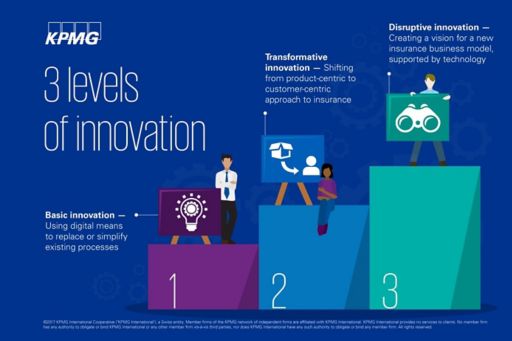The digital transformation of insurance: Getting fit for digital
Getting fit for digital
First published in The Digital Insurer.
The insurer of the future will look drastically different than today’s incumbent model. Technology has the potential to fundamentally change not only the way that consumers perceive and interact with their insurers, but also the role of insurance in everyday life. Instead of being a back end purchase in the wake of decisions surrounding home, health, travel and more, insurance could instead become a major part of the front end ecosystem. And we are already seeing the first steps of this change—but significant challenges bar the way forward. How should an organization meaningfully pursue industry-changing digital innovation?
Understanding the potential depth of change
Customer needs are changing, with digital products and purchase options becoming more critical for the modern consumer. Yet the range of technologies used to enable digital services have varying business impacts. When we look at the potential of digital innovation, we can classify it into three levels: basic, transformative, and disruptive.

Basic innovation can be defined as using digital means to replace or simplify existing processes. Examples seen today include process automation, chatbots, cloud computing, and AI triaging high-volume, low-value claims. These areas represent incremental improvements that can deliver benefits in the short term. This is where most insurers are focusing much of their time and attention today.
In contrast, transformative innovation has the potential to change the way that insurers interact with their customers. Key to this transformation is a shift from a product-centric to a customer-centric approach to insurance, in which AI, big data and analytics are used to understand customers and provide data to allow decision makers to act quickly. This approach not only helps insures understand how to better reach potential markets and through what channels, but also provides the ability to design products for customers based on their needs. On-demand coverage is an important first step on this journey.
Another example is the way that some insurers are using technology to support a mindset shift from protection to prevention. One insurer in Singapore has introduced a program that provides affordable insurance to diabetics while assisting individuals in managing their condition. Using portable monitors that track health information such as blood sugar, heart rate and weight, the insurer is able to lower their risk profile while providing coverage to an underserved market. Other examples range from mobile risk alerts based on a consumer’s location to health trackers that notify a woman of potential issues with her pregnancy before the unborn child is at risk.
Disruptive innovation is both the most meaningful and most challenging to achieve. Instead of looking at specific technologies, disruptive innovation is about creating a vision for a new insurance business model, supported by technology. Today’s business models will not survive in tomorrow’s digital landscape—insurers must evolve to survive. To achieve the vision of an insurer being at the front end of a customer’s daily transactions, such as new purchases, travel, or trips to the doctor, the way that an insurer operates needs to be reconsidered from the ground up. Use of technology thus becomes the means to achieving that clear and specific vision for the business rather than a goal in and of itself.
How should an insurer move forward?
Insurers are understandably mired in immediate issues. Challenges surrounding legacy IT systems, changing regulations, rising competition and low consumer trust, all loom large in the traditional insurer’s windshield. As a result, many incumbents fail to create a clear digital vision to guide activities, or to make day-to-day decisions to move the organization meaningfully toward the achievement of that vision. Creation of such a vision, as well as a roadmap of the way forward, is a critical first step.
Next, insurers need to address four key components of their business:
- Shift product mindset. Today, most insurers think in terms of specific product lines instead of the needs of the customer buying the product. Insurers should shift their focus to consumer needs and anticipate how changing behaviors will create opportunities for new products.
- Seek technology partnerships. Building or buying technology solutions may no longer be the best option. Instead of developing an in-house solution, companies should look to partner with insurtech and fintech companies who can provide immediate digital capabilities.
- Address backend processes. Legacy processes can be a stumbling block to change. While more insurers are offering digital products, few have reengineered their backend to match, creating inefficiencies and increasing the risk for error. Insurers need to address these gaps and take advantage of the opportunities of improving digital processes.
- Create a culture of innovation. There is nothing that an insurer does today that cannot be innovated upon, transformed, or entirely rethought using enabling technology. Yet to seek and embrace this innovation requires organization-wide cultural change. From the C-suite to the mail clerk, insurers need to ask their employees to seek opportunities for innovation, with KPIs to measure performance and incentives to spur activity. Such a culture will also help insurers make considerable strides in attracting and retaining digital talent.
There is no direct path
As part of an inherently risk-adverse industry, many insurers have been approaching digital innovation with caution, even hesitance. Yet the basic, step-by-step approach to innovation embodied in pilot programs and discrete innovation groups will achieve one result: being left behind.
Disruptive change is already occurring within the industry, driven by new and developing technologies. Digital insurers, fintechs and insurtechs unencumbered by legacy systems, processes and people are already pushing the boundaries and are at the forefront of the industry. This change will only accelerate. Embracing disruptive innovation at a cultural level is a significant challenge—but it is better than the inevitable alternative.
The writer is Chia Tek Yew, Partner and Head of Financial Services Advisory, KPMG in Singapore. The views expressed are his own.